This telescope glossary is designed to help you understand any acronyms or terms you may not be familiar with when reading our articles.
- Visual astronomy
- Aperture
- Field of view
- Focal length (telescopes)
- Focal length (eyepieces)
- Focal ratio
- Atmospheric seeing
- Light pollution
- Eye relief
- Collimation
- Magnitude
- Plate Solving
- Electronically Assisted Astronomy (EAA)
- Mount
- Optical tube assembly (Optical tube, OTA)
- Lens cell
- Mirror cell
- Dovetail
- Saddle
- Reflecting telescope (Reflector)
- Refracting telescope (Refractor)
- Cassegrain telescope (Cass)
- Catadioptric telescope (CAT, Cat)
- Eyepieces
- Barlow lens
- Finderscope/finder
- Filter
- Focal reducer
- Fastar/Hyperstar
- Field flattener
- Dew shield
- Optical Defects
- Astrophotography Related
- Glass Types
- Deep-sky objects
Visual astronomy
Astronomy where you look through an eyepiece.
Aperture
The diameter of the main (objective) lens or mirror of the telescope, usually measured in millimeters or inches.
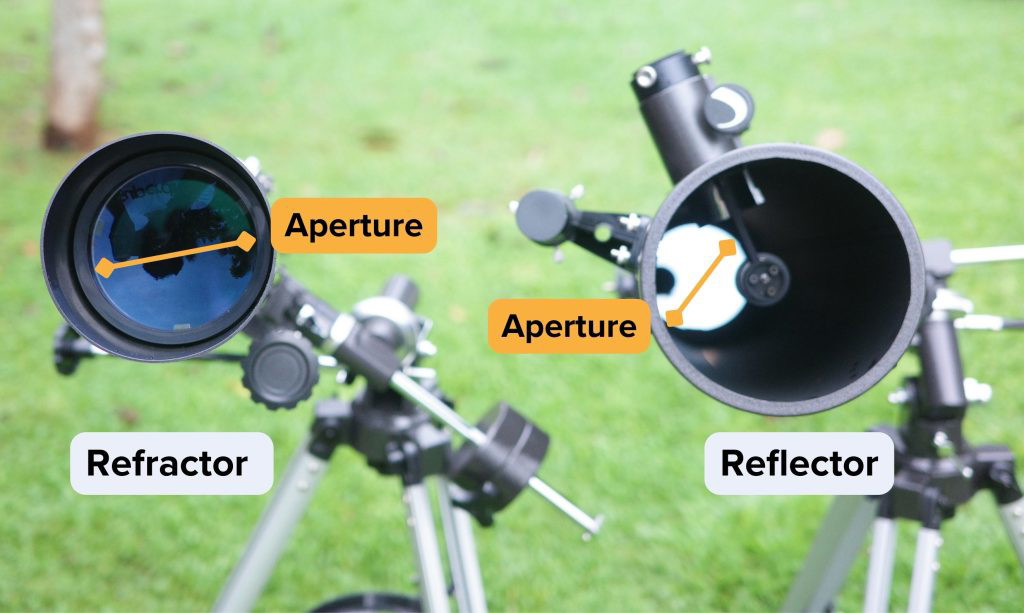
Field of view
The area of sky you see looking through the eyepiece or in an astrophotograph. This could refer to either apparent field of view (AFOV) or true field of view (TFOV).
Apparent field of view (AFOV)
AFOV is the actual angular width of the view you see through the eyepiece if you held it directly up to your eye without using a telescope.
This is usually measured in degrees and is a characteristic attribute of the eyepiece. Most standard eyepieces that ship with telescopes will have an AFOV of around 50 degrees or less. Most of the most expensive eyepieces, however, have much larger apparent fields of view, from 68 degrees to 82, 100, or even 120 degrees.
True field of view
The actual area of sky you are looking at in a given eyepiece/telescope combination.
Learn More: For a detailed explanation of field of view, including how to calculate true field of view, check out my in-depth guide here: Field of View Explained.
Focal length (telescopes)
The focal length of a telescope is the distance the main objective—usually a lens or mirror—of the telescope focuses light. It is usually measured in mm.
The focal length determines the magnification of the telescope along with the eyepiece. A shorter focal length means that the telescope will have less magnification. To calculate magnification, just divide the focal length of your telescope by that of the eyepiece.
Focal length (eyepieces)
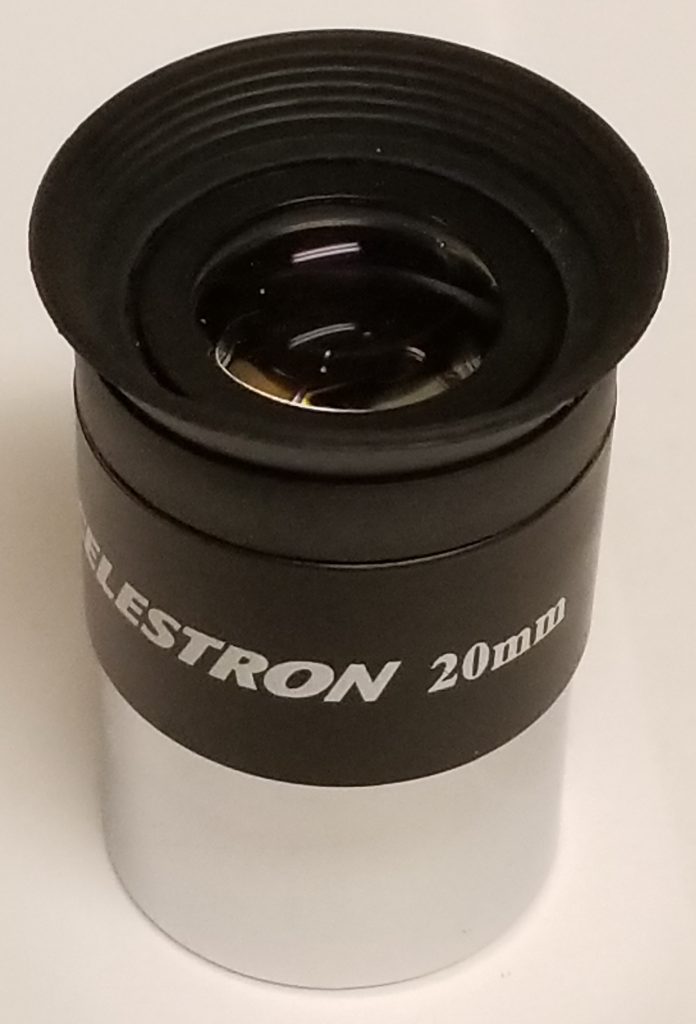
The focal length of an eyepiece determines the magnification it provides when used with a telescope. The shorter the focal length, the more the magnification. Magnification is also dependant on the telescope’s focal length. To calculate magnification, just divide the focal length of your telescope by that of the eyepiece.
Focal ratio
The ratio of the aperture to the focal length of a telescope. A higher focal ratio is often described as a “fast” focal ratio. Faster telescopes often have more problems with aberrations, particularly coma in Newtonians.
What do “fast” and “slow” focal ratios mean?
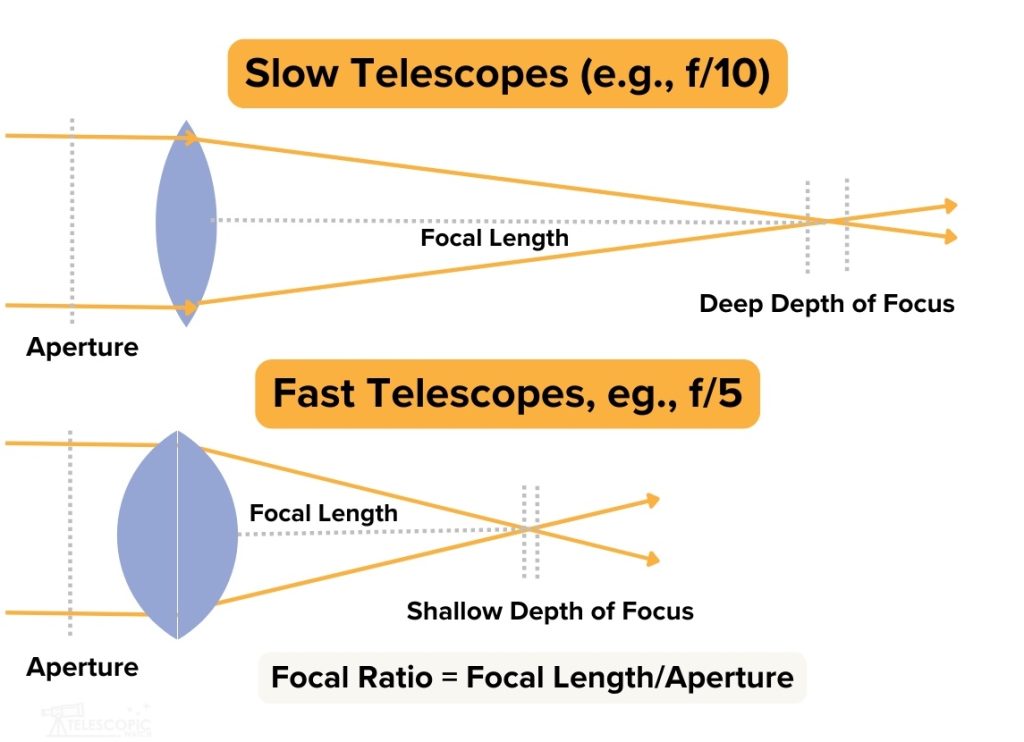
“Fast” refers to a low focal ratio/f-number (for eg.: f/2). “Slow” refers to a large one (for eg.: f/15). For astrophotography, you want as fast a focal ratio as possible.
Atmospheric seeing
Atmospheric seeing is the quality of the view through the atmosphere.
As the atmosphere is made of air, it can act as a massive lens. Air currents shift stars slightly, which is noticeable to the eye as twinkling stars. You will most likely experience the negative effects of atmospheric seeing at high magnifications, where the view through the telescope seems to boil and shift around, especially when the atmosphere is particularly turbulent. This could make the views to be unsatisfactory, especially on planets.
Light pollution
The unwanted, unnecessary, and wasteful illumination of the night sky by humans. Light pollution not only severely hampers astronomy; it is also a threat to wildlife such as sea turtles, birds, and nocturnal animals of all types.
Learn More: Detailed guide on light pollution.
Eye relief
The distance you can place your eye from an eyepiece before the field of view starts to vignette. Long eye relief eyepieces are best for eyeglass wearers; but unless you have severe astigmatism, you don’t need to wear glasses at the eyepiece anyway.
Collimation
Collimation is the alignment of a telescope’s optics so that they are all on-axis and deliver the clearest and brightest views. See my guide to learn how I’m collimating my scopes.
Magnitude
The magnitude of an object is how bright it appears to the eye. Magnitude is measured based on a certain amount of light. A higher value of magnitude means that the target appears dimmer in the sky, and as the value increases, targets become exponentially more dim.
Magnitude is most useful for stars as they are effectively point sources of light, but in nebulae magnitude becomes useless as large nebulae are measured based on their total light output. For nebulae, surface brightness is a better indicator.
Plate Solving
An advanced set of procedures and algorithms that allow your camera to determine where your telescope is pointing in the sky. This helps with centering dim targets that are not visible through the viewfinder and also for aligning your mount. You can also use platesolving to analyze images to get information on what stars and other objects are in it.
Electronically Assisted Astronomy (EAA)
Amateur astronomy where one views a live stacked image on a screen, as opposed to taking still frames or looking through an eyepiece.
EAA’s supporters view it as a way to “cheat” light pollution and artificially increase the aperture of their telescope.
It’s detractors, which includes myself, view it as a pointless endeavor which requires tons of money and commitment for a rather unexciting result – why not just look at Hubble pictures on your TV instead of spending money to view low-quality live images? Additionally, I believe that it is a defeatist solution to the problem of light pollution.
Mount
The tripod/tracker/platform that the telescope is on that is used to point the telescope and in many cases to track the sky.
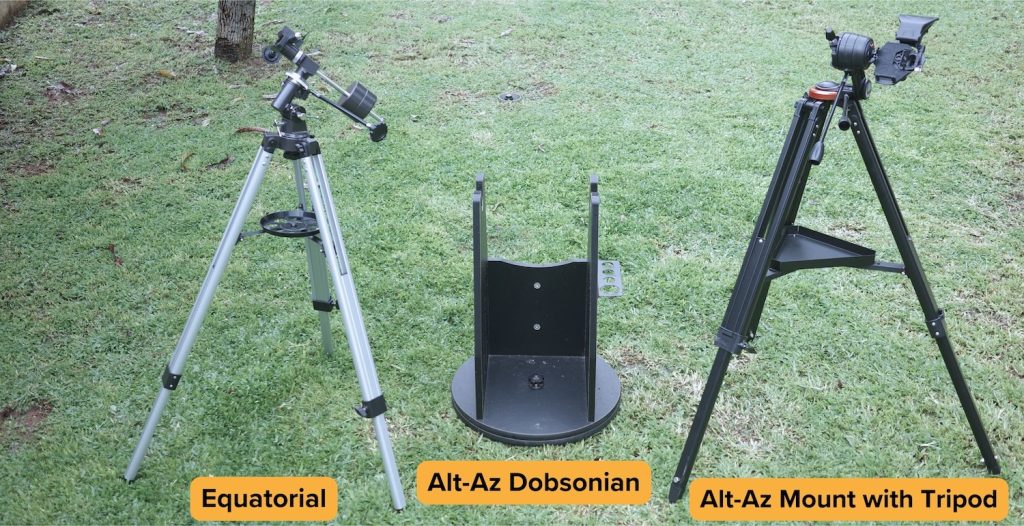
Equatorial mount
A mount that only tracks on one axis, called Right Ascension (RA), which is aligned to the north or south celestial pole depending on your position on earth. A second axis, called Declination is used to position the mount alongside RA, however, it does not actively track when you are finished moving the mount.
Deep-sky astrophotography basically requires an equatorial mount.
German equatorial mount (GEM)
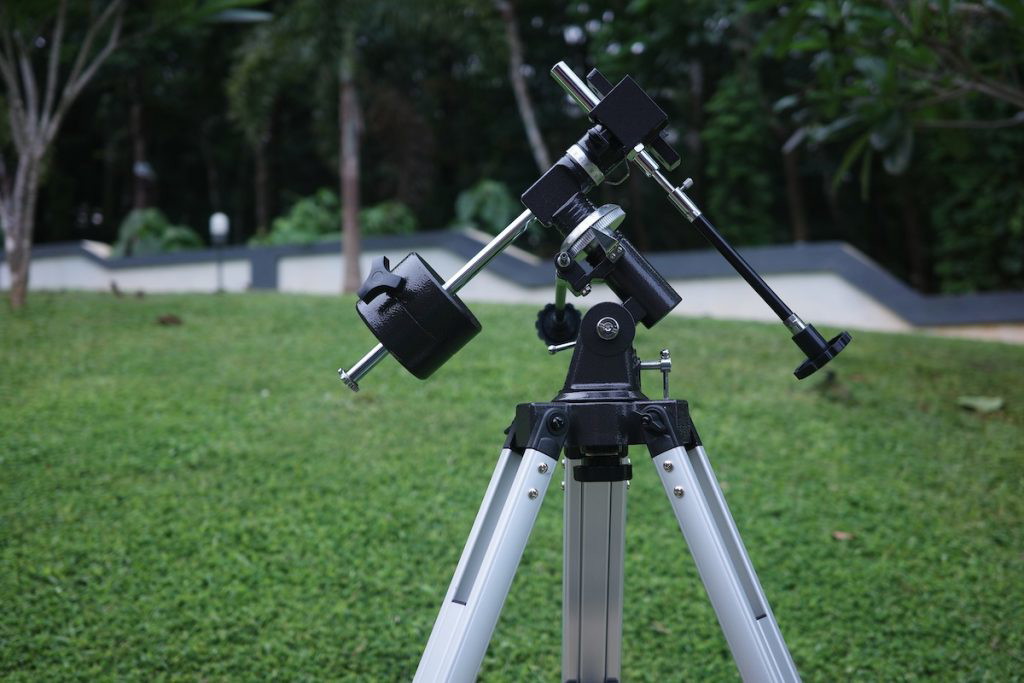
A German equatorial mount is the most common type of equatorial mount. The telescope sits on one side of the mount, and opposite it there is a long bar with a weight on the end. The telescope’s weight is counterbalanced by a counterweight. The bar uses the mechanic of leverage to balance a heavy telescope with a generally less heavy weight made of solid iron or lead. The innovative design of a GEM is that you can use a variety of telescopes and not have to purchase specific counterweights as you can move the weight closer up or further down to the center of the mount to balance the telescope.
Alt-azimuth mount (Altaz, alt-az)
Altitude (Alt) and Azimuth (AZ) are the 2 directions that correspond to up-down and left-right in telescope mounts. Thus, an altaz is simply a mount that you can pan upwards and downwards and swivel side to side.
Altaz mounts are great for beginners due to their simplicity and low cost. They are just fine for visual astronomy and short-exposure astrophotography. However, for long-exposure deep-sky astrophotography, you need an equatorial mounting.
Optical tube assembly (Optical tube, OTA)
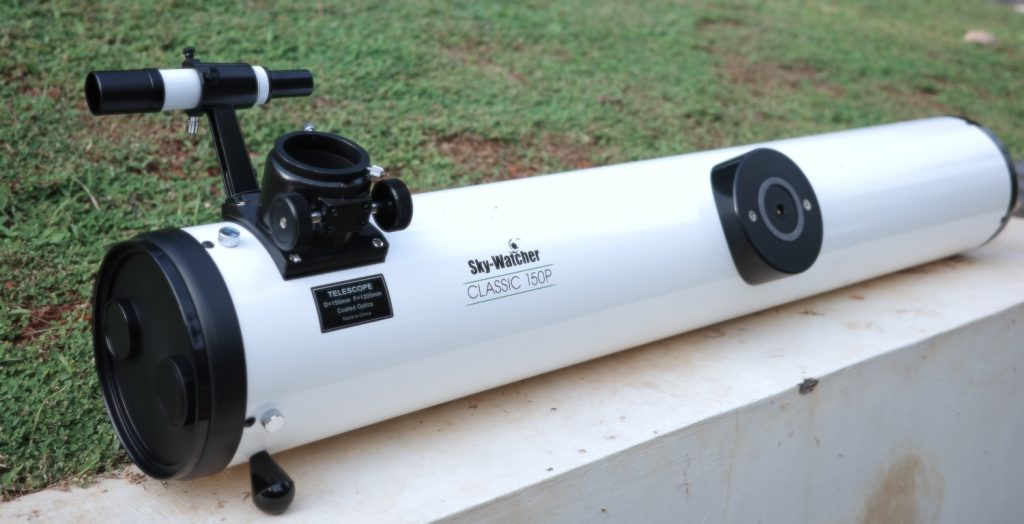
The actual “telescope” part of your telescope, which includes the objective lens or mirror and any additional optical elements and a focuser. Your eyepiece, finderscope, etc. all attach to the OTA and the OTA itself must be attached to a mount to point it at the sky and support it.
Solid tube
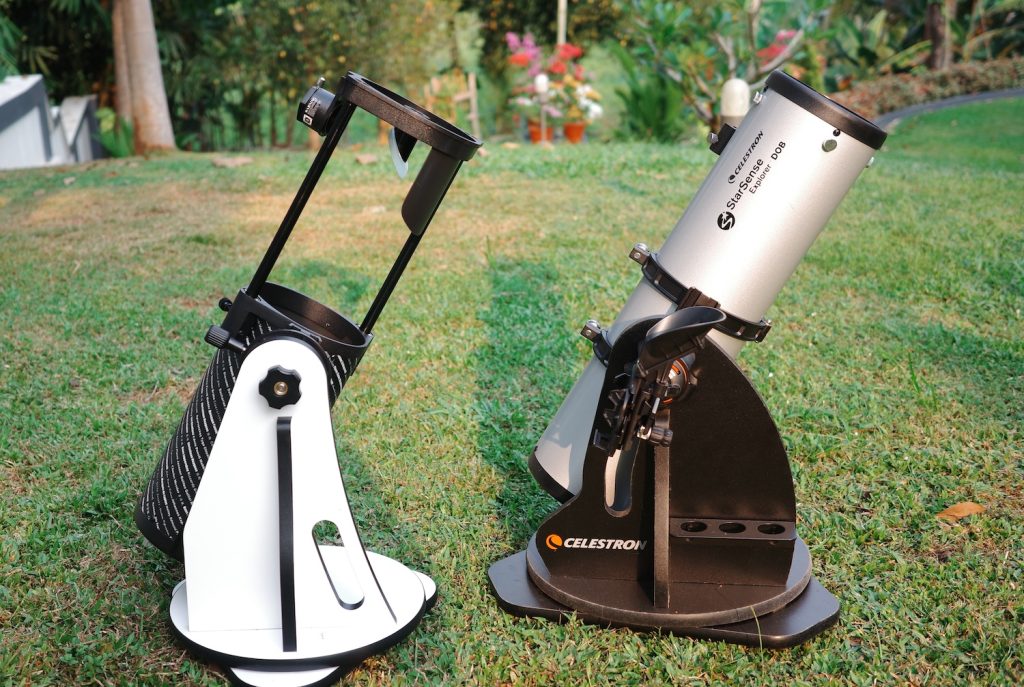
A telescope that has a monolithic tube of aluminum, steel, carbon fiber, phenolic resin, or cardboard as opposed to one made out of collapsible trusses.
Truss tube
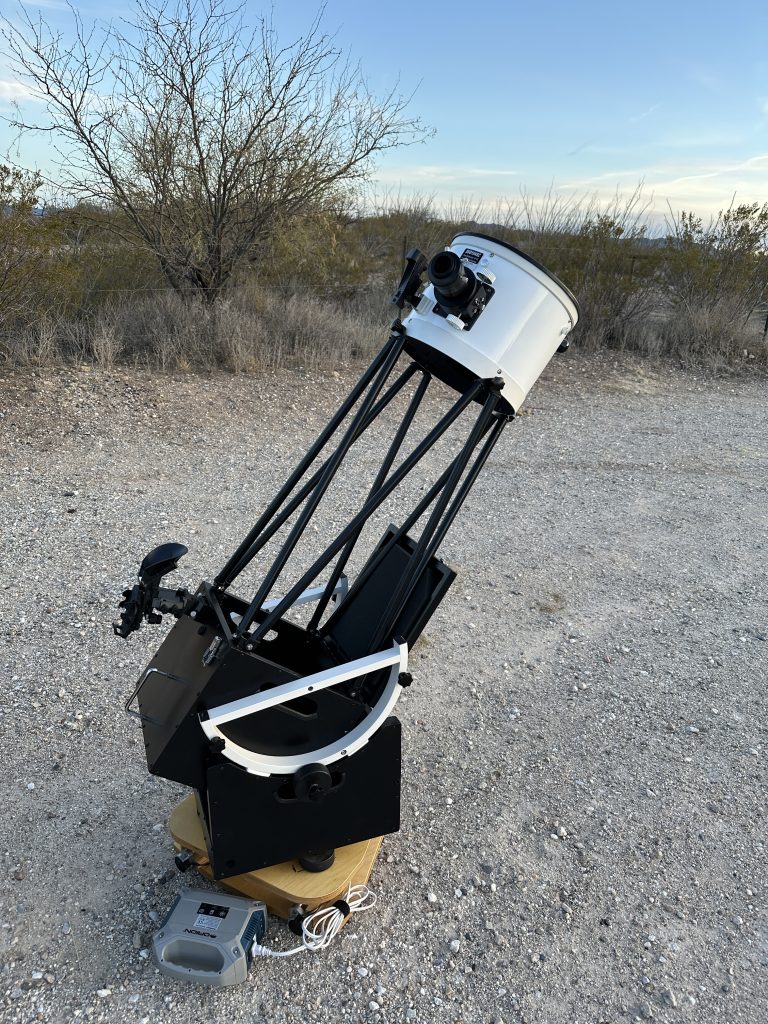
A telescope “tube” that uses several (usually eight) metal poles to hold the bottom and top portions together, rather than a solid metal or phenolic tube.
Lens cell
The part of a refracting telescope that holds a lens in place. Typically tightened with a spanner wrench. A good lens cell will not pinch the lens and allows for collimation adjustments.
Lens element
A piece of precision ground and polished glass that may be cemented, taped, or air-spaced with another lens element to form a complete lens or lens group.
Mirror cell
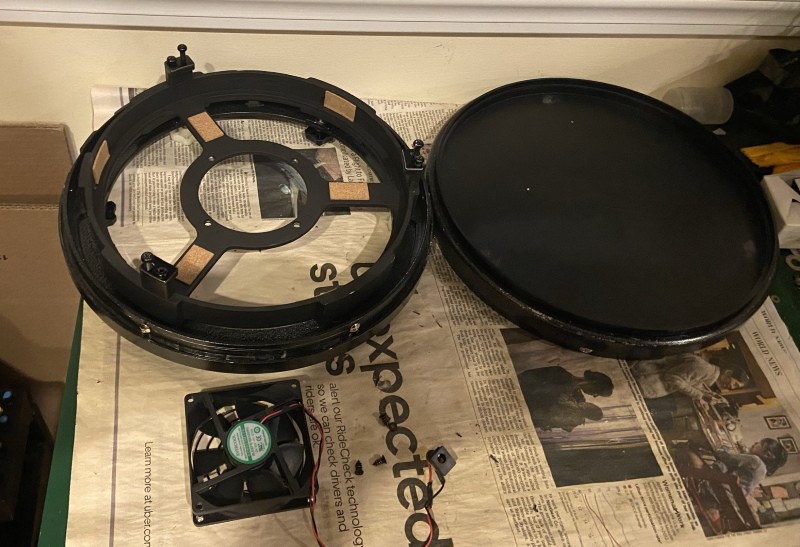
A support mechanism that holds the primary mirror of a reflecting telescope, typically with 3, 6, 9, 18, or 27 floatation points, and often retaining clips and/or a sling or edge supports. A good, well-designed mirror cell will prevent the mirror from sagging and “potato chipping” when aimed closer to horizontal, as well as from deforming under its own weight.
Spider
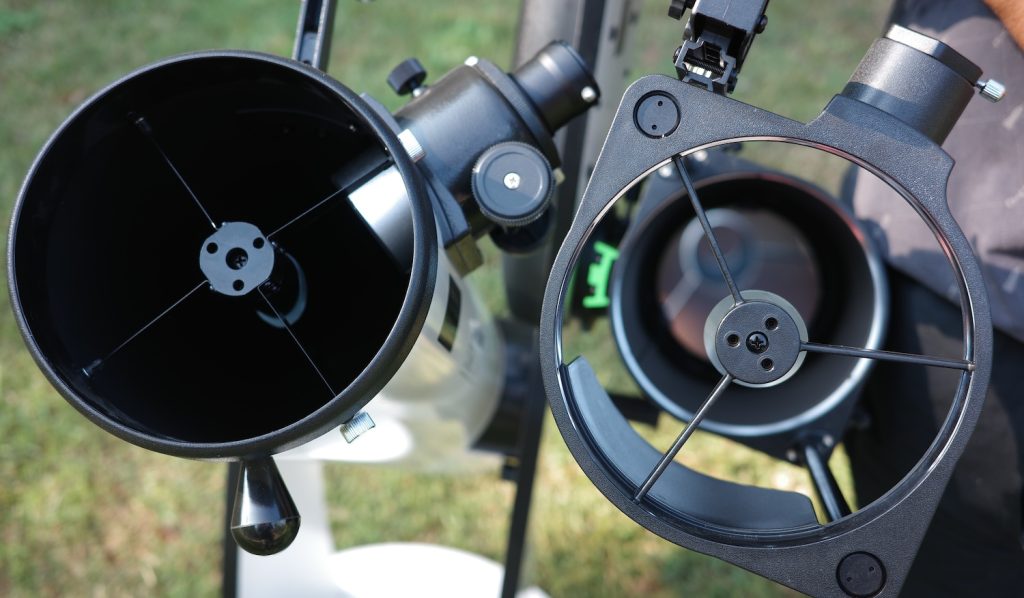
The + or triangle-shaped metal supports that hold the secondary mirror in a Newtonian, Ritchey-Chretien, or any other reflecting/catadioptric telescope without a corrector lens at the front. Most spiders also have adjustments for collimating your secondary mirror.
Coatings
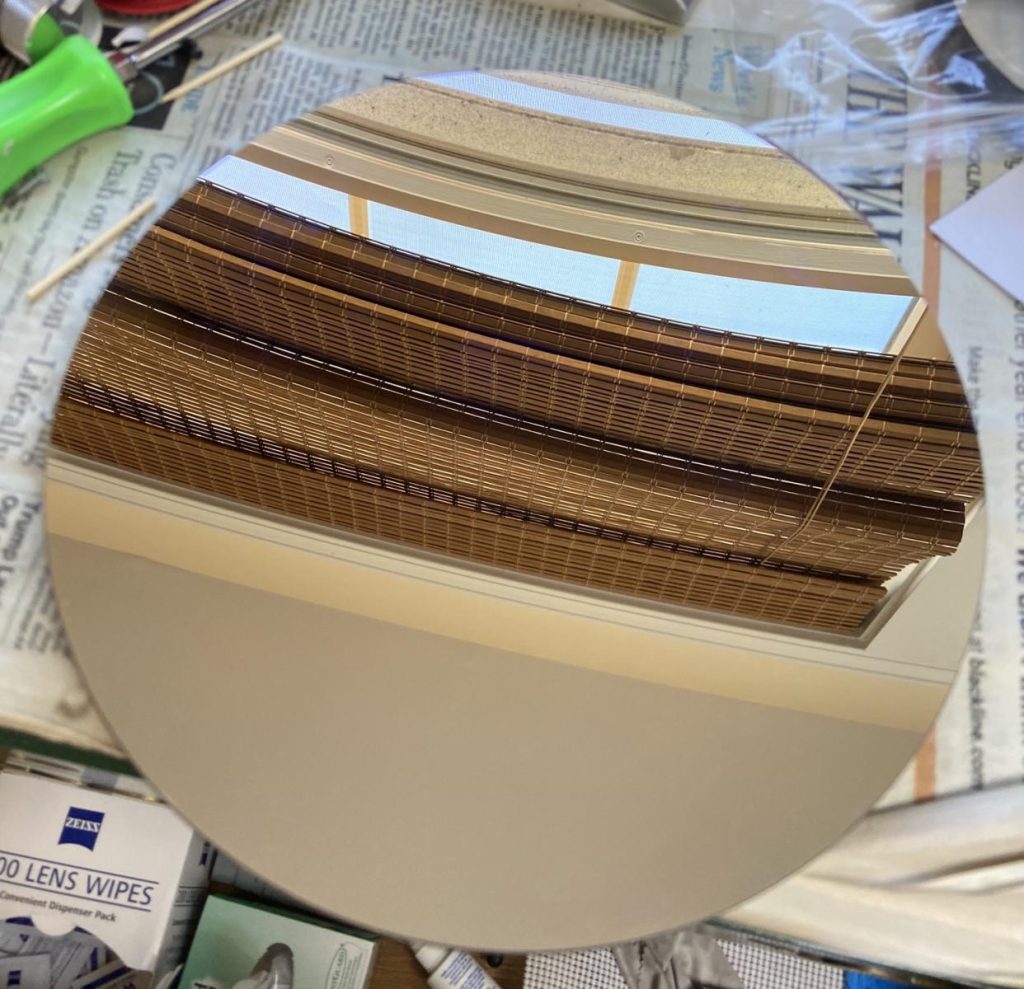
When buying any astronomy item that uses lenses or prisms—such as a telescope, binoculars, eyepiece, Barlow, or diagonal—look for one that is fully multi-coated.
A coated lens or prism has a substance of some kind coating it to prevent the glass from reflecting or scattering light, which can otherwise reduce image brightness and contrast. Multi-coatings are typically more advanced and will reflect/scatter even less light.
“Coated” or “Multi-coated” means that only the glass surfaces that face air are coated, whereas “full” coatings mean that every surface, including lens elements that touch each other.
Dovetail
A specially-shaped metal plate that allows interchangeability of telescopes and mounts, and allowing us to mate them together. Typically found in Vixen and Losmandy styles.
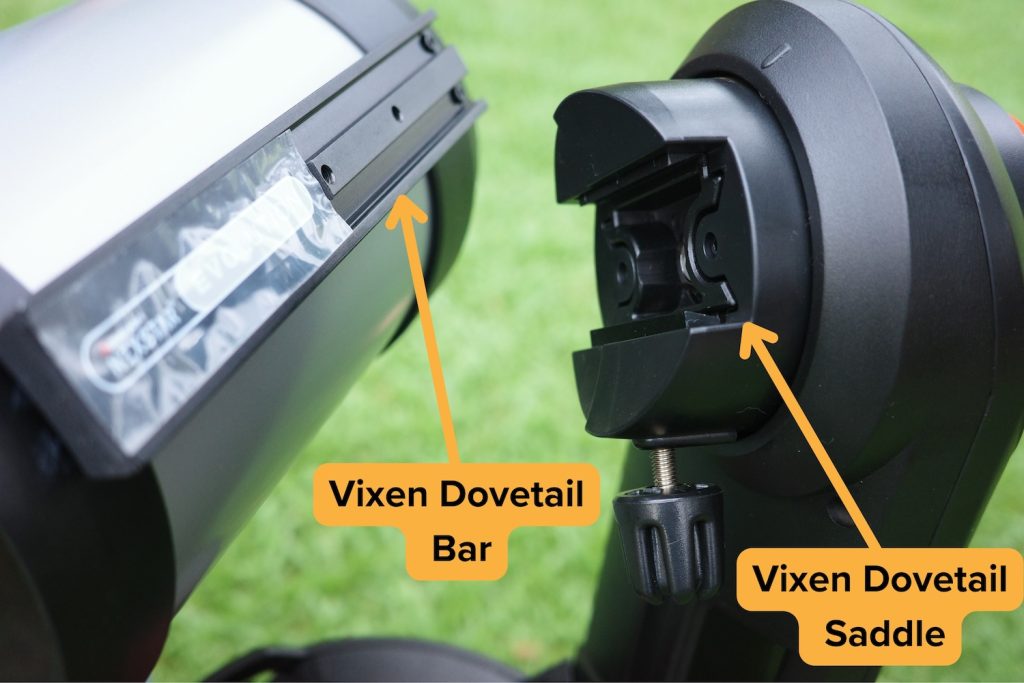
There is also a smaller version of the dovetail found in finderscopes, which usually use either a Meade-style or Synta-style plate and shoe/saddle.
Vixen-style (Vixen) dovetail
A narrow dovetail commonly used on small telescopes, and mounts with under 30 pounds of weight capacity. Invented by Vixen in the 1980s.
Losmandy-style (Losmandy) dovetail
A larger, flatter dovetail than the Vixen style used on heavy-duty mounts and larger telescopes, especially when astrophotography is involved. Invented by Losmandy in the 1990s.
Saddle
The part on a mount that accepts a dovetail. Cheap saddles use screws to lock onto and “bite” into the dovetail, while more expensive saddles use clamping action for a more symmetrical fit which doesn’t mar the finish on the dovetail.
Reflecting telescope (Reflector)
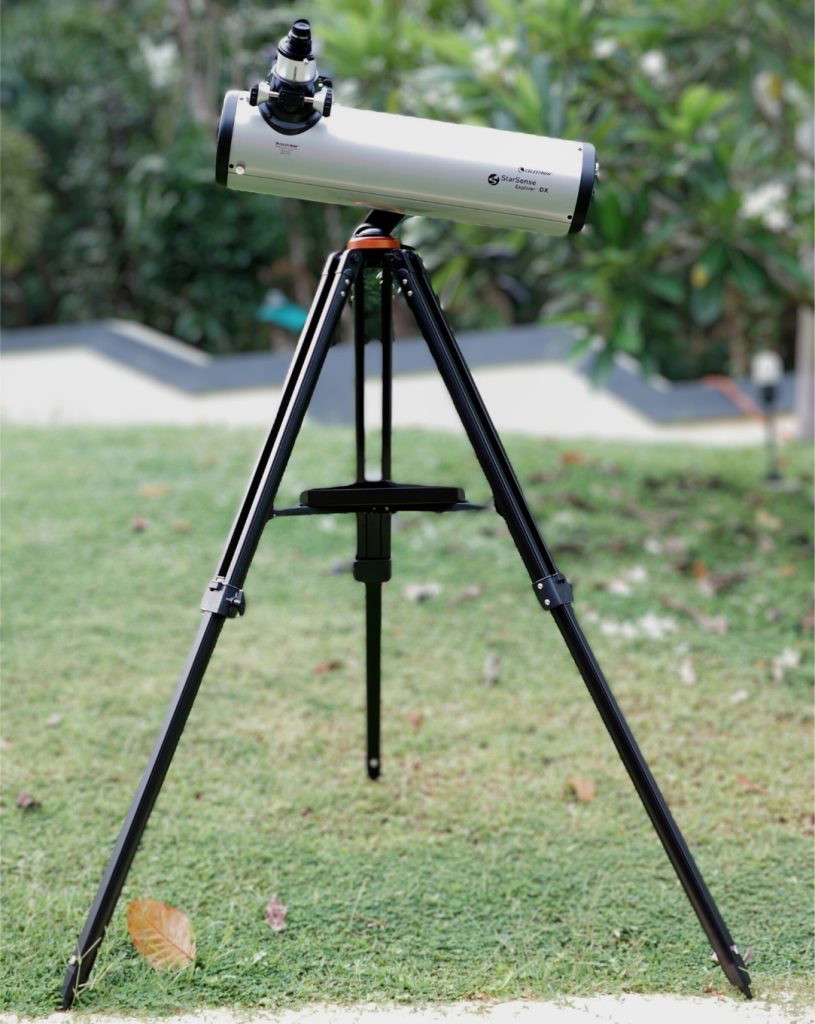
A telescope that uses a precision mirror as the objective to focus light. Most reflectors use at least two mirrors. Most reflectors are variations on the Newtonian or Cassegrain designs.
Dobsonian/Dob
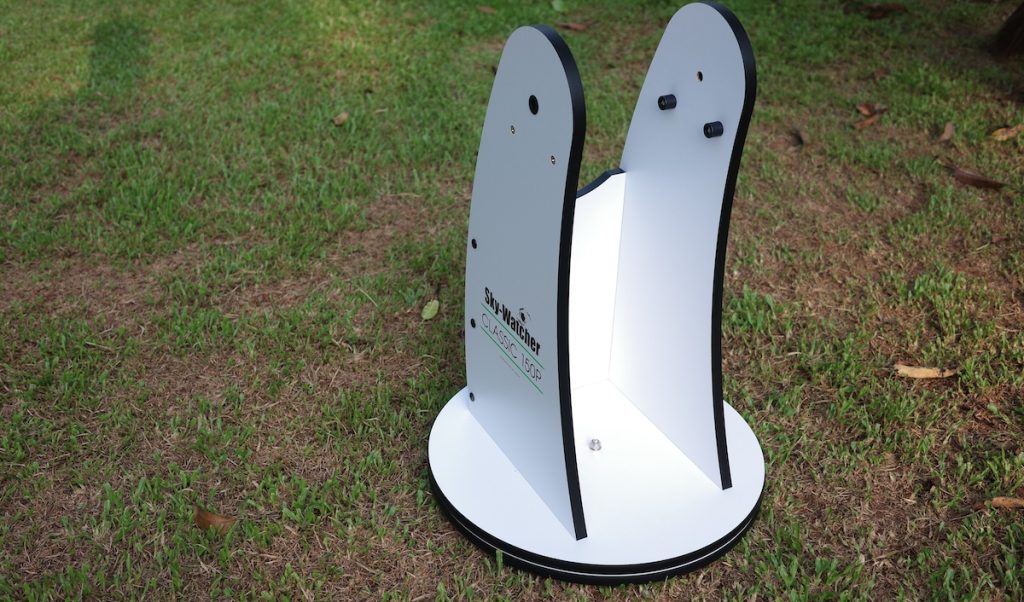
A Dobsonian mount is an altazimuth mount that is commonly used with Newtonian telescopes, because it is easy to use and simple to construct.
Invented by John Dobson in the 1960s, the Dobsonian mount is extremely simple in construction, being made mostly of wood, and the bearings are nothing more than Teflon or similar material, controlled entirely by friction—except in computerized or motorized versions, which use gear-driven bearings alongside the standard materials..
Maneuvering a Dob is dead simple—just push it! There are no clamps, locks, slow-motion knobs, etc. needed.
Bird-Jones
A catadioptric variation on the Newtonian reflector with a spherical primary mirror and a sub-aperture corrector lens/Barlow.

The proper Bird-Jones design places this corrector before the secondary mirror, which makes for ideal correction and easy collimation. However, I’ve noticed that Bird-Jones scopes marketed by major brands not only refuse to state that they are Bird-Joneses, but they also improperly execute the design and put the corrector inside the focuser, as illustrated in the diagram above. With this arrangement, the correction is usually not ideal and precise collimation of the telescope is impossible.
My advise is to avoid “Newtonians” that have longer focal lengths than its physical tube length – such as the 114 x 1000mm, 127 x 1000mm, and 150 x 1400mm as these are all poorly made Bird-Jones telescopes.
Refracting telescope (Refractor)
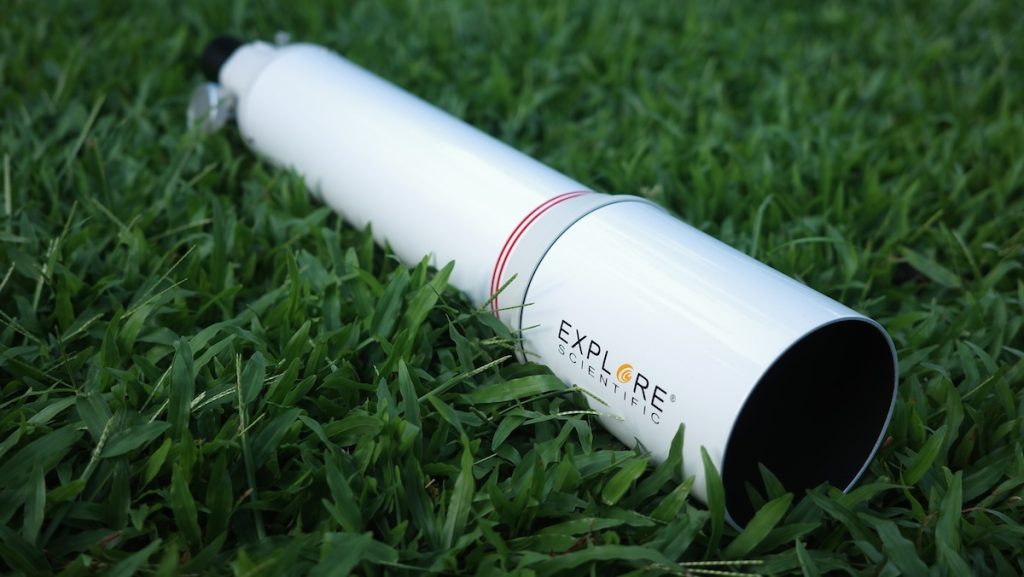
A telescope that uses a lens as the objective to focus light. Modern refractors are typically of at least the achromatic type, which uses two lenses to focus light. More expensive refractors often use extra-low dispersion glass and/or triplet or quadruplet objectives for maximum color correction and flatter fields for astrophotography.
Achromat/Doublet
A type of refractor that uses two lens elements to partially deal with chromatic aberration. Most inexpensive refractors below the $1000 range are doublets.
Cheaper achromatic doublets (achromats) using regular crown and flint glass suffer from lots of chromatic aberration (particularly if they are faster in focal ratio), while more expensive doublets use ED glass to control chromatic aberration further. For best results in astrophotos, however, a triplet refractor is ideal.
Triplet refractor (triplet, ED triplet)
A type of refractor that uses three lens elements in its objective lens, usually with some ED glass as well to almost completely get rid of chromatic aberration.
Petzval
A 4-element, 2-lens refractor design with a 2-element objective lens at the front and a 2-element reducer/corrector lens at the back. Petzvals have extremely flat fields and thus don’t need a field flattener. But I’ve particularly experienced that the chromatic aberration in Petzvals without ED glass is too high for anything more than casual astrophotography.
Astrograph
A term used to refer to telescopes designed primarily for astrophotography. Astrographs typically have fast focal lengths and higher weight than visual telescopes and may or may not be capable of reaching focus with an eyepiece.
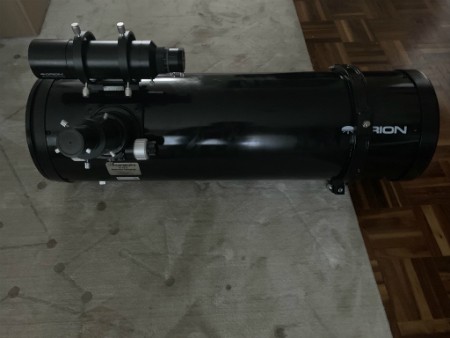
Cassegrain telescope (Cass)
A type of reflecting telescope that uses a concave primary mirror and a convex secondary mirror to focus light back through a hole in the primary mirror. The original (Classical) Cass uses a parabolic primary mirror just like a Newtonian reflector, and a convex hyperbolic secondary mirror. Casses and their derivatives offer long focal lengths and extremely short/compact optical tubes.
Ritchey-Chretien (RC or RCT)
A variant on the Cassegrain telescope that uses a hyperbolic concave primary mirror and a hyperbolic convex primary mirror. Ideal for astrophotography. Some famous Ritchey-Chretiens include the Hubble Space Telescope and the LORRI instrument on the New Horizons spacecraft.
Catadioptric telescope (CAT, Cat)
A telescope using both lenses and mirrors. Most commercial Cats are simply a modification of a Cassegrain or Newtonian design, but there are more exotic Cats that are based on neither. Common Cats include the Schmidt-Cassegrain, Maksutov-Cassegrain, Schmidt-Newtonian, Maksutov-Newtonian, and Klevtsov-Cassegrain designs.
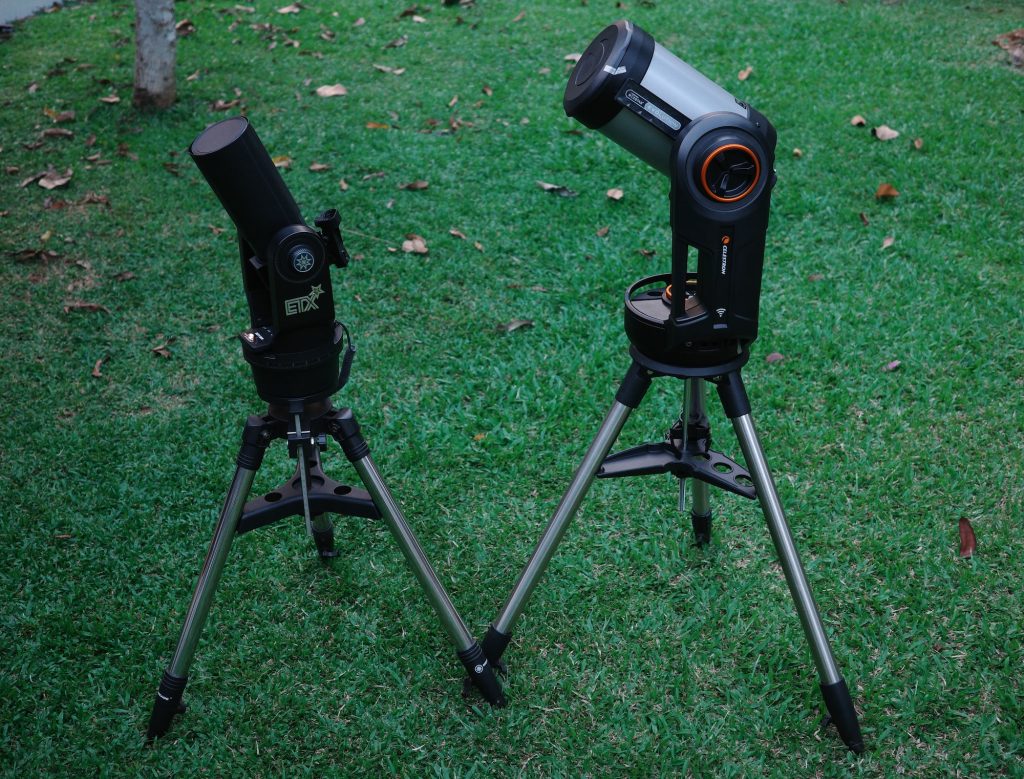
Maksutov-Cassegrain telescope (MCT, Mak, Mak-Cass)
A catadioptric variation on the Cassegrain. Gregory Maks, the kind most often seen, use a spherical concave primary mirror, a Maksutov corrector lens, and an aluminized “spot” on the back of the Maksutov corrector serving as the secondary mirror.
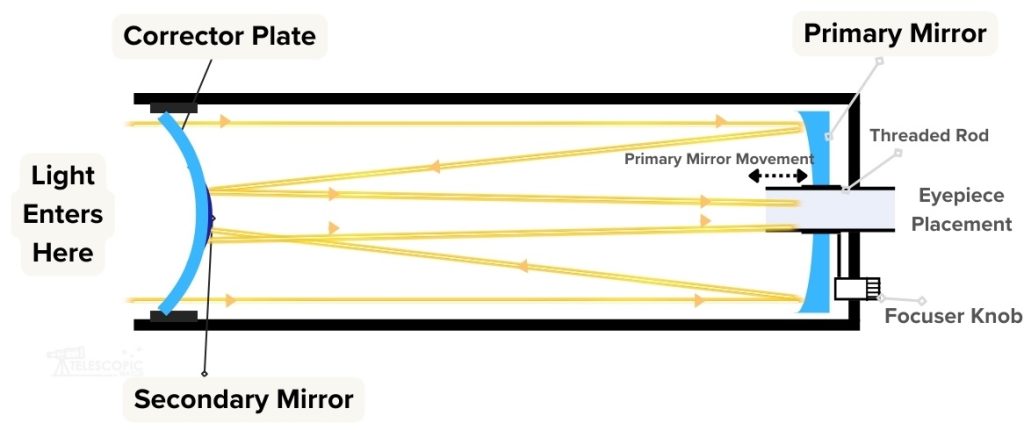
Most Maks made today focus by moving the primary mirror along a threaded rod, which can induce image shift and mirror flop.
Maksutov corrector
A meniscus-shaped corrector lens, similar to the Schmidt corrector, used in various catadioptric telescope designs.
Maksutov-Newtonian telescope (Mak-Newt)
A Newtonian telescope that has a Maksutov corrector on the front and uses a spherical primary mirror. Like a Schmidt-Newtonian, Mak-Newts have less coma than a regular Newtonian as well as no diffraction spikes but at the cost of having to deal with dew on the corrector and increased price.
Schmidt-Cassegrain (SCT, SC, Schmidt-Cass)
A catadioptric variation on the Cassegrain. SCTs use a spherical concave primary mirror, an ellipsoidal (nearly spherical) convex secondary mirror, and a Schmidt corrector to focus light. Most SCTs made today focus by moving the primary mirror along a threaded rod, which can induce image shift and mirror flop.
Schmidt corrector
A thin lens of plate glass molded into a 4th-order curve, almost flat to the eye. This can be done in several ways. The first is via grinding and polishing by hand, which is extremely complicated and tedious due to the nature of the 4th-order curve. The second is the vacuum pan method, where the glass is warped by a vacuum on one side and ground/polished on the other – this method requires extreme care and is extremely difficult to do right. The third, which most manufacturers of Schmidt-Cassegrain and Schmidt-Newtonian telescopes do today, uses a vacuum to press the corrector to the shape of a “master block” (basically a mold) for easy, repeatable mass-production of Schmidt correctors.
Schmidt telescope
An outdated term, which technically refers to any telescope with a Schmidt corrector but is more commonly used to refer to an SCT.
Schmidt camera
A type of telescope that uses a spherical primary mirror and a Schmidt corrector, with a camera at the focal plane of the telescope – there is no secondary mirror. The classical Schmidt camera puts the film, glass plate or digital camera inside the telescope behind the corrector, while newer designs like the Celestron RASA put the camera outside the telescope, attached to the corrector.
Schmidt-Newtonian (S-N, SNT)
A Newtonian reflector but with a spherical primary mirror and a Schmidt corrector at the front. S-Ns have less coma than an equivalent Newtonian and the attachment of the secondary mirror to the corrector lens eliminates diffraction spikes. However, S-Ns have the disadvantage of having an expensive corrector plate which is fragile, drives up cost, and can easily dew up.
Eyepieces
Huygens (H)
The first real eyepiece type developed, invented in the 1600s. They consist of two convex lenses. I’ve only seen Huygens eyepieces being often supplied with either old or very cheap telescopes only. They are generally only usable with very long focal length telescopes at very high powers, otherwise they will have severe aberrations.
Ramsden (R, SR)
A slightly better eyepiece than the Huygens, invented in the 1700s. Still not a great option.
Kellner/Modified Achromat (K, MA)
A decent beginner eyepiece, often found in cheap binoculars or with inexpensive telescopes. Consists of a doublet lens and a singlet lens.
Reverse Kellner/Rank Kellner (RKE)
A reversed version of the Kellner eyepiece design. Long eye relief and sharp views, but not the widest field of view. Uncommon, but still available from Edmund Optics.
Orthoscopic
An older, extremely sharp eyepiece design. Not very common anymore.
Plossl
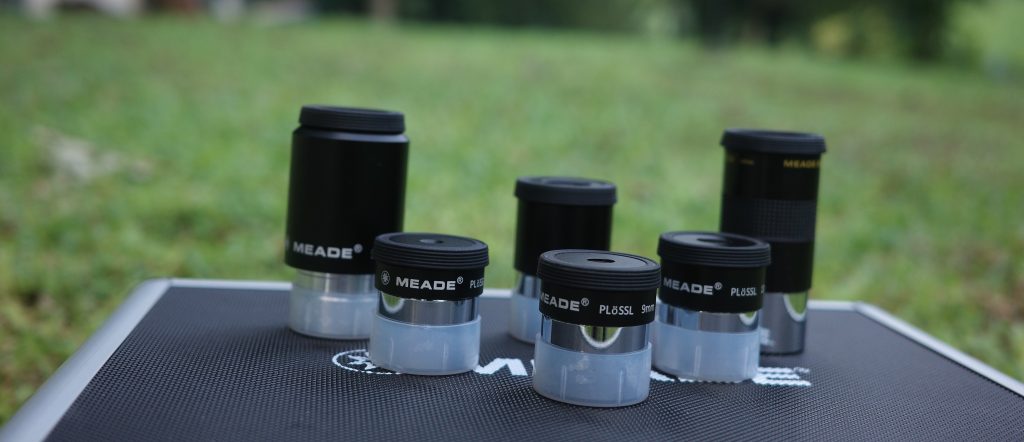
A decent eyepiece and one commonly found with beginner telescopes. The Plossl eyepieces does its job admirably with almost any telescope, but some may desire a wider field of view or longer eye relief.
Erfle/Wide Angle (WA)
An early wide-angle eyepiece design. Most inexpensive wide-angle eyepieces are based on the Erfle design. They work okay with long focal length telescopes but the edge of the field of view is not very crisp with faster instruments.
Nagler/Ultra Wide Angle (UWA)
A type of eyepiece that uses at least 8 lens elements to create a wide, 82-degree apparent field of view. Invented by Al Nagler. Naglers/UWAs are expensive as they start at around $80 apiece and can fetch up to $500, depending on brand name, focal length and quality. The field of view in these eyepieces is very much like a “spacewalk” – you can find the edge but it’s hard to notice. I find the views of the Moon at high power with these eyepieces to be extremely satisfying. Using a high-power UWA with a telescope that is not equipped with a motor drive will keep the object in the field of view longer.
Barlow lens
A Barlow is a diverging lens (usually at least achromatic and preferably apochromatic) that multiplies the focal length of your telescope, which is the equivalent of multiplying your magnification or image scale. Due to the availability of quality short focal length 1.25” eyepieces, I do not recommend Barlows for much besides planetary imaging.
Finderscope/finder

A smaller scope mounted on the telescope for finding objects. Most good finderscopes have a decent aperture of at least 40mm and a magnification of 10x or below. Alternatively, there are other finders such as the Telrad and Rigel Quikfinder, which are reflex sights that project circles like a target onto where the telescope is pointing.
Red dot sight, red dot finder (RDF)
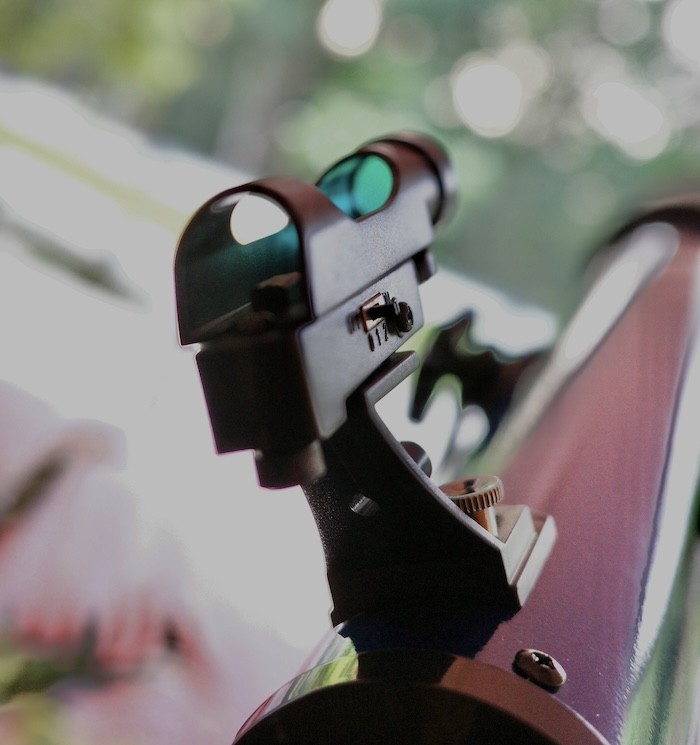
A type of sight used on many inexpensive telescopes that simply projects a red dot onto the sky. RDFs are extremely cheap and easy to operate. But due to the lack of light-collecting ability provided by a finderscope nor the reticle markings provided by a reflex sight they are pretty useless for pointing at anything besides the Moon, planets, stars, and maybe a few bright deep-sky objects.
Reflex sight
A type of finder similar to a red dot sight, except it projects a “bullseye” of several degree circles on the sky, typically in 0.5, 2, and 4-degree increments. These reticles can be used to measure distances in the sky to find objects – it sounds confusing but it’s arguably easier than using a finderscope!
Rigel Quikfinder
A type of reflex sight.
Telrad
A type of reflex sight.
Filter
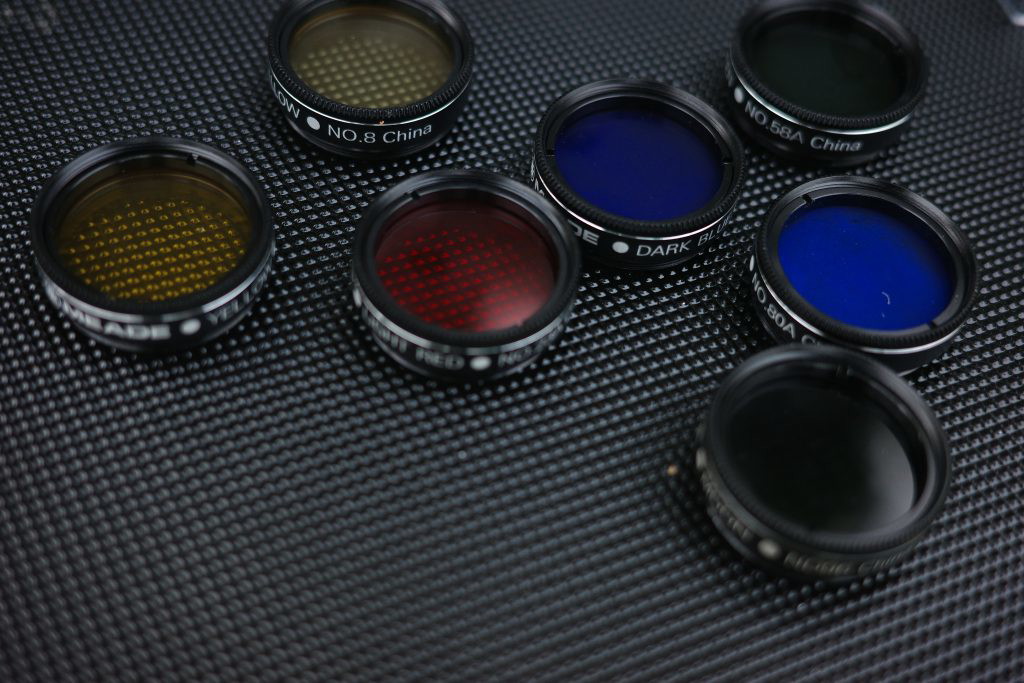
A filter prevents certain wavelengths of light from reaching the eye/camera sensor. Filters are used with monochrome astrophotography cameras to achieve a color image or shoot narrowband images, in color astrophotography to reduce light pollution’s effect on images, and in visual astronomy to increase contrast on nebulae.
Focal reducer
A focal reducer is an optic, typically added at the focuser, but before the camera. As the name implies, it reduces the focal ratio of the telescope. These work well on refractors but not so well on reflecting telescopes such as newtonians, as there is no way to correct coma and reduce the focal length at the same time.
From my experience, cheaper focal reducers impacts viewing quality but high quality reducers allows me to have great lower magnification views.
Fastar/Hyperstar
The Fastar/Hyperstar system is a lens that replaces the secondary mirror of Celestron Schmidt-Cassegrain telescopes. It converts the natively f/10 focal ratio telescope into an f/2 Schmidt camera.
One concern I’ve is that the system unfortunately places the camera at the front of the telescope which makes wire placement and use of filter wheels tricky, and doesn’t allow for large cameras to be used.
Both systems have been arguably superseded by the RASA line of telescopes, which accomplish exactly the same thing with the drawback of not being able to remove them from the telescope.
Field flattener
A special lens set that you insert into the back of your telescope and fixes the problem of field curvature in a refractor or Ritchey-Chretien.
Dew shield

A preventative measure used to delay the formation of dew on your telescope mirror or lens. Dew heaters are the only true solution to the dew problem by heating the lens or objective above the dew point.
Optical Defects
Astigmatism
Astigmatism is a type of optical defect that can be found in every type of optic. If the optic is astigmatic, it means that it has a microscopic “pringle” or saddle shape, where two ends are high, and at 90 degrees the edge is low. Astigmatism is particularly important to eliminate in reflecting telescopes, as it can severely degrade the view.
Astigmatism can be caused by improper support of either the back or edge of a telescope mirror, or it can even be polished in due to improper support of the mirror when it was being figured. It can also be caused by having a poor-quality secondary mirror, a pinched primary mirror or objective lens, or by using a cheap eyepiece.
Chromatic aberration
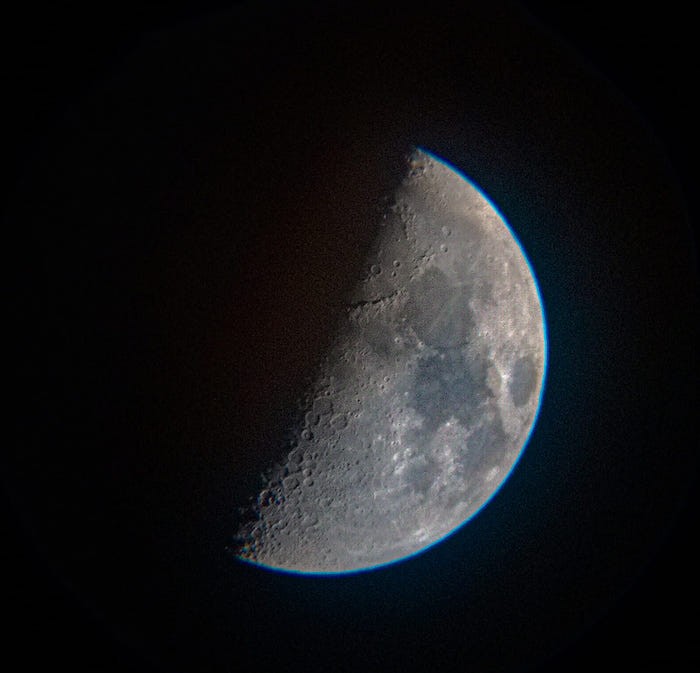
A problem common in achromatic refractor telescopes caused by different wavelengths of light focusing at different points. Stars with chromatic aberration appear to have a halo (usually purple) around them and image sharpness also suffers.
Coma
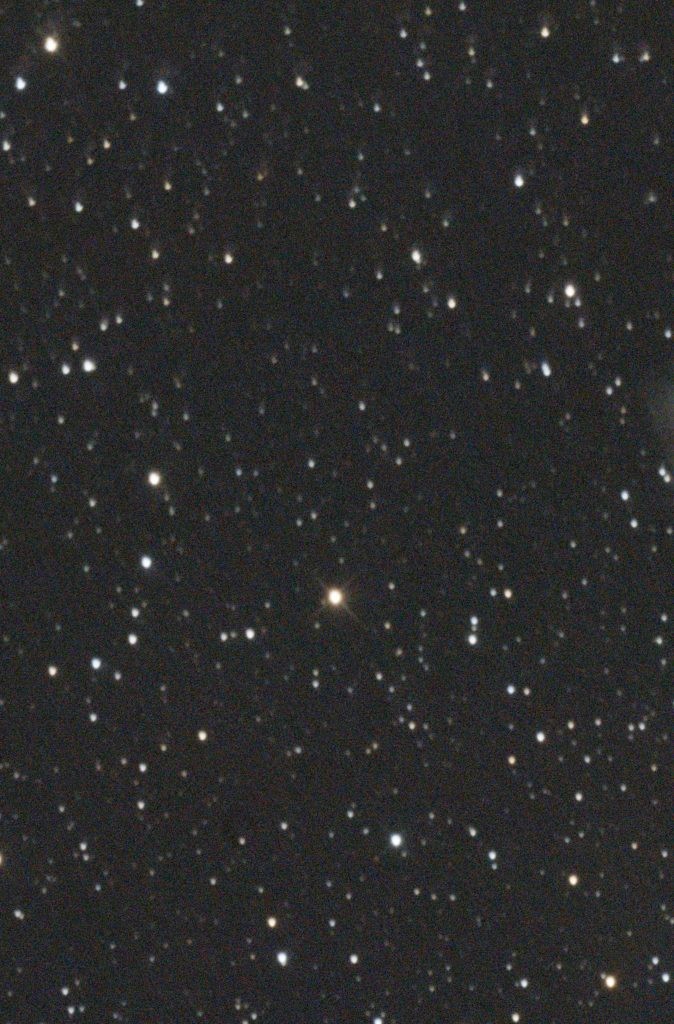
An aberration in fast reflectors and in Schmidt-Cassegrain telescopes where stars at the edge of the field of view appear like elongated “seagulls”. It is worsened when our scope is not properly collimated.
Coma in reflectors can be solved with a coma corrector, and in SCTs it is generally miniscule enough to ignore.
Diffraction spike
Spikes that appear on stars and the planets in Newtonian, Ritchey-Chretien, and other reflectors which have a spider to hold the secondary mirror. 4-vane spiders produce 4 bright spikes while a 3-vane spider produces 3 dim spikes. Using a curved-vane spider can reduce diffraction spiking at the cost of a tiny amount of image sharpness.
Field curvature
A problem with astrophotography with refractors and Ritchey-Chretien telescopes where the field of view appears to be curved and stars at the edge are elongated. It appears that you’re zooming towards or away from the field of view. It can easily be solved by a field flattener.
Field curvature also occurs with certain eyepieces, but this cannot be solved with a flattener.
Spherical Aberration
A flaw in a telescope where light is not focused to a sharp point. This is usually caused by poor-quality optics and thus not possible to remedy without reshaping the primary mirror, which may be more expensive than a new telescope.
Turned-down edge
A flaw in a telescope mirror (or sometimes, lens) where the edge of the optic has a longer focal length than the rest of it. A variety of conditions can cause turned-down edge. The only real cure is to refigure the mirror, but it can also be remedied by simply stopping down the telescope’s aperture very slightly.
Vignetting
Vignetting is when light at the edge of the field of either an eyepiece or camera dims. Vignetting occurs when something is blocking off the light that would normally reach the edges of the field of view. It can occur when filters are too small, the secondary is too small, the telescope’s tube is too long or for many other reasons. Usually vignetting is fixable if you can locate the cause of the issue.
Astrophotography Related
Autoguider/autoguiding
Autoguiding is a system used to correct minor errors in a computerized mount’s tracking. Autoguiding is almost always necessary for long exposure imaging, as small shifts in tracking can cause easily noticeable streaking in images.
Autoguiding is usually done by mounting a small telescope called a guide scope to the main imaging telescope, and looking through it with a camera. Software then locks onto a star and watches it to see when it shifts, and moves the mount accordingly.
Autoguiding is only possible with computerized mounts, and ideally a computerized equatorial mount.
Guide scope
A small telescope (usually a refractor) which is piggybacked to your main telescope during astrophotography, and used for autoguiding.
Periodic error (PE)
PE is a tracking error in an equatorial mount that repeats due to slop or inaccuracy in the mount’s gears. PE can be corrected for with Periodic Error Correction (PEC) or autoguiding.
Piggyback astrophotography
This is a type of astrophotography where you attach your camera to the top of your motor-driven telescope. The telescope serves as nothing more than a giant coupler for the camera to attach to the mount in this scenario, and you shoot your photos with merely a standard camera lens attached to the camera.
Stacking
A commonly used astrophotography technique that uses the combination of many shorter exposures, commonly called subs, to create one image with the combined exposure time of all the subs. This is also used in planetary imaging with some differences; planetary imaging only stacks the best percentage of images. The “best” images are found using software that detects which images had the best seeing, this is why planetary imagers use video instead of images and need extremely fast frame rates.
T-ring/T-adapter
A pair of threaded adapters; the T-ring attaches to the bayonet mount on your DSLR camera and threads onto the T-adapter which you insert into your telescope for astrophotography.
Glass Types
BaK-4
Barium crown glass, a high-quality optical glass used in good prisms and lenses.
Plate glass
Regular soda-lime glass, just like the kind used in your window panes (but not tempered). Often used in low-cost or homemade telescopes.
Low-expansion glass
Glass that expands and contracts less with temperature changes than regular plate glass – Pyrex is an example.
PYREX (borosilicate glass)
A special type of glass, often used in telescope primary mirrors. Pyrex expands and contracts less with temperature than plate glass, which means it cools down faster. It is also slightly stronger than plate glass. However, it is significantly more expensive and harder to grind.
Extra-low dispersion (ED) glass
Extra low dispersion glass or ED for short is a type of glass that has a high transmission percentage. This means that a very high amount of the light going through the glass is passed through to the other end of the optics, compared to other glasses which absorb more in comparison. Typically the difference is hard to notice, but it is still important if you wish to view the dimmest of objects. This also helps in reducing chromatic aberration in refractor telescopes.
Deep-sky objects
Anything outside the Solar System that is not simply a star or a star system (so not binary, triple, quadruple, etc. stars). Objects that fall under this category include nebulae, star clusters, galaxies, and supernova remnants.
Index Catalog/IC (Object designation IC)
A supplementary 5386 deep-sky objects to the New General Catalog. Many IC objects are observable with small to large telescopes.
New General Catalog/NGC (Object designation NGC)
A catalog of 7840 objects composed by John Luis Emil Dreyer in 1888. The New General Catalog contains almost all of the objects discovered by the Herschels and a few other pioneering astronomers.

I am pretty new at all this. Also live in NYC, but like to travel to dark areas upstate.
I have been eyeing the Unistellar eVscope equinox.
It has attractive features, including sharing with scientists and the fact that it says, by using its software and gathering light over time, it can image even in light pollution.
Wondering what you think of this scope.
It’s an overpriced scam, avoid.
You might want to look again at your description above of ED glass, – which has nothing to do with transmittance of the glass. It has to do with low variation in refractive index across differing wavelengths of visible light. I am sure you know that, and the above is just a proof-reading type of mistake, but needs correction.
P.